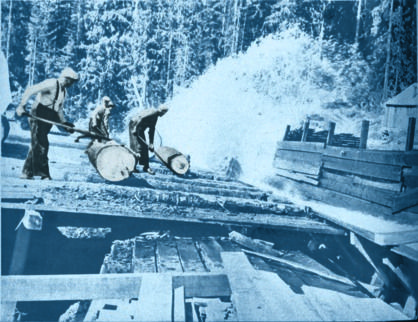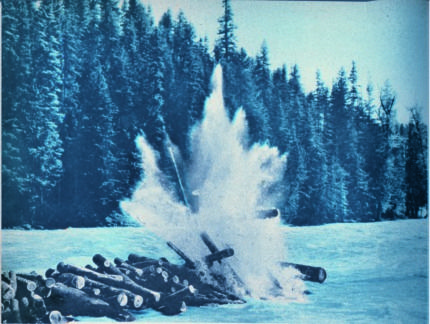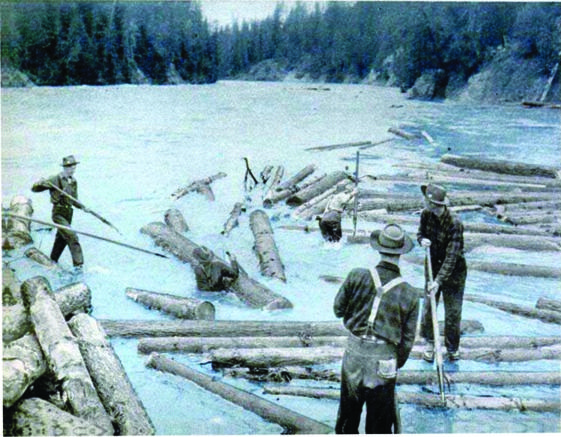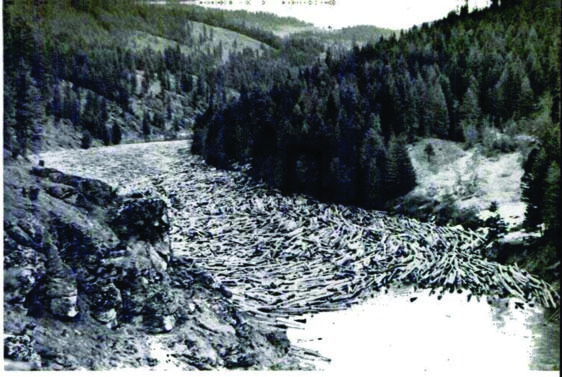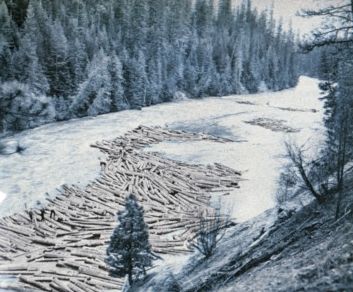Although railroads and trucks had made the log drive an anachronism by 1949, when this story first ran, the method was still used. In the summer and winter in Idaho’s panhandle, lumberjacks floated logs in the river. In spring, they broke up the jams that formed and collected the logs at the other end.
It was a center jam—a potential man killer. Huge 16-foot saw logs, weighing up to 2,000 pounds, crunched against one another like shoestring potatoes in a crazy man’s skillet. The wooden carpet that had been slithering, jostling, and churning toward the sawmill stopped dead. Logs were jammed up for half a mile back.
The river boss was all over the place, trying to find the key log. When he spotted it, a dozen men set their peavey hooks into it and strained. No go. Then the river boss ordered a charge of dynamite. “Whoomp!” went the explosion and a white plume of water shot skyward. That did it. “She’s a-pullin’!” went up the cry.
As the grumbling logs began to move downstream like half-submerged alligators, the men scrambled to safety. One of them miscalculated and plunged into the icy water. A pal gave him a helping hand. Another, unable to reach dry land, dug his spiked boots into a slippery timber and birled downriver.
That’s a log drive—one of the most spectacular and action-packed features of America’s annual timber harvest that reaches a total of 35 billion feet a year.
It’s true that railroads and trucks have relegated most American and Canadian log drives to the history books. But this spring, two of the biggest drives in history are being conducted in the wilderness of Idaho’s panhandle. Both will be at their height this month. One drive is down the north fork of the Clearwater River and is bossed by “Boots” Edelblute for Potlatch Forests, Inc., who operates a 300,000-acre tree farm, one of the largest in America. This drive was temporarily abandoned during World War II, but is being resumed this spring on a larger scale than ever. Some 50 million feet of timber are herded down 120 miles of the Clearwater River from Beaver Creek to the sawmill at Lewiston.
The other is the Priest River drive, under the direction of veteran Bill Whetsler, who runs logs for the Diamond Match Company. Since 1901, this drive has sent logs swirling down the 65-mile stretch of white water between Priest Lake and the Pend Oreille River.
Men who work the log drives are called “riverjacks” or “riverhogs.” Like whooping cranes, sea otters, and passenger pigeons, they are an extinct species in most parts of the United States. But today in rough and rugged northern Idaho, you’ll find them as numerous as ever.
What lures a man into this arduous, dangerous life?
It’s certain not merely the wages. Riverjacks average about $90 a week and board. It’s something more than money. Perhaps it’s that thrilling brush with death that airplane test pilots experience. Or the struggle with nature that a deep-sea diver knows. Maybe it’s the challenge of physical skill required of a tightrope walker.
Whatever the lure, it’s something that gets into a riverjack’s blood and stays there for life. Men who leave the river for safer jobs in cities and on farms often drift back. After the war, riverjacks who had been drafted promptly returned and asked for their old jobs.
During the sawmill days of summer and the backbreaking task of winter logging, lumberjacks may find their work a chore and a bore. But when spring comes and ice begins to break up on the river, they suddenly become the aristocrats of the lumbering industry—riverjacks. And for four months—March, April, May, and June—the riverjack is king of the North Woods.
Because the 65-mile Priest River is flanked by a good highway, Bill Whetsler’s Diamond Match crew drives out from the town of Priest River each morning in trucks, drives back again at night. That’s luxury unheard of in the old days. On the other hand, the Potlatch riverjacks enjoy no such conveniences. They run a log drive like their forefathers 100 years ago.
During the summer and winter preceding the drive, logs are cut in the woods and flumed to Clearwater River. Some logs are floated as much as five miles in the flumes. Other logs are trucked to the river and dumped in. The logs float downstream until they hit an obstruction forming a jam.
Then when spring comes, the Potlatch crew goes to work—freeing logs that have lodged on the riverbanks and in jams at the center.
Working with pike, peavey, brawn, and sure-footed skill, the riverjacks follow the tree trunks downstream like cowboys driving a herd of cattle over the old Chisholm Trail. Most logs float downstream without any trouble; it’s a small 10 to 15 percent that makes riverjacks necessary. Logs get stuck in the mud or entangled in low-hanging branches, jam on submerged rocks, against islands, or in the elbows of curves.
Annoying pileups that latch on one bank or another are wing jams. Logs jammed against a sand bar in the middle of a river are center jams. They’re the trickiest and most dangerous.
Center jams are unraveled from the downriver end of the pileup. There are two very good reasons for this point of attack: (1) The key log, the one that holds up all the others, is probably at the lower end of the jam and when it is freed the others can move; (2) should a riverjack lose his footing and fall into the water, he can be rescued at the downriver end.
One of the biggest jams on the Clearwater occurs each year at Big Riffle, about halfway down, where the river narrows between rocky banks. A solid phalanx of 12 to 15 million feet of timber blocks the river at this spot until rising water frees it.
When working on jams, riverjacks always have nearby a bateau—a double-prow, flat-bottom boat 32 feet long, six feet wide, manned by two men with oars and two others with long poles. When a man goes overboard, the bateau can be quickly maneuvered into position so that he can be pulled out. Much of the time, riverjacks work in ankle-deep icy water and frequently up to their chests in water. A man who plunges in up to his neck is said to have “washed his clothes”; if he goes in over his head, he’s said to have “closed the door.” But no matter how wet they get in the icy water, riverjacks keep on working. Woolen clothes and exercise keep them fairly warm if not dry.
Principal tools of a riverjack are his pike pole and peavey. The pike is an eight-foot staff with a hickory handle and a steel point at the end. It’s used mainly for pushing and guiding logs. The peavey is a five-foot tool with a hook at the end used principally for turning logs over. These two tools, plus the old reliable, dynamite, have a long history among American loggers.
No riverjack would get near a log without a pair of well-calked boots. He calks his own—as often as once a week, depending upon how soon the needle-sharp points are dulled by granite rocks. A slippery-shod pair of feet is an invitation to disaster. Worn-out calks are removed promptly with chisel and hammer. This leaves gaping holes in the outer sole of the boot. These holes are filled with square pegs of white pine and new calks driven into the wood. As the wood gets wet, it swells, the calks becoming a solid and inseparable part of the boot. Some riverjacks prefer to use small pieces of overall cloth instead of wood. When a riverjack finds himself on a single log rushing downstream, he’s thankful for his calked boots. It’s a highly skilled art to remain upright on a slippery log, 24 inches in diameter, as it bounces along in rough water. Balancing with the body and arms and turning the log with the feet is an accomplishment known as birling. In some parts of the United States, birling contests are annual events. Someone has called them “one of the few truly native American sports.”
Following behind the riverjacks are two wannigans—24-by-84-foot log rafts on which are built a canvas-covered bunkhouse and cookhouse. Only a few old-timers still possess the knack of constructing a wannigan that will survive the log drives.
These rough-hewn showboats of the log drive are put together at the upper end of the river and follow the riverjacks downstream—tying up along the bank each night. When they reach the millpond, they’re knocked down, thus adding a few more logs to the supply.
Guiding the clumsy flatboats calls for expert navigation. Frequently, the bows are under water in the rapids. Fifty-foot sweeps, fore and aft, are used to guide the craft. They lumber along, scraping over half-concealed rocks, slamming into the river’s banks. But somehow the wannigans hold together, principally because of the tough vines used to bind the logs.
Riverjacks work from 7 a.m. to 4 p.m. This means breakfast at 6 a.m., first lunch at 10 a.m., second lunch at 2:30 p.m., and dinner at 7 p.m. Breakfast and dinner are served from the wannigans. Lunches are brought to the riverjacks on the job.
And man, what food! Great platters of ham and eggs, loaves of oven-hot bread and pans of browned biscuits, enormous two-inch steaks, great pots of beans, cookies and doughnuts by the score, huge cups of steaming coffee, crates of oranges and apples. The diet is heavy on the side of sugars and starches because they provide quick energy.
“You can get a lot of logs down the river with a sack of sugar,” one mill owner is fond of saying.
At night, the riverjacks make camp alongside the river. After dinner, a big black cauldron is suspended over a roaring fire. This provides hot water for bathing, shaving, and laundering. Boots are rinsed free of sand and hung to dry atop the hickory handles of peaveys jabbed into logs. When the boots shrink, it’s easy to fill them with hot water before breakfast and pull them on—a kind of self-inflicted hot foot!
A “cat raft” (a Caterpillar tractor mounted on a raft) floats downstream in the wake of the main body of logs to help in “picking off ” or “sacking” the rear—freeing logs that have become stuck or stranded.
In the rough upper country, as a general rule, logs are moved by manpower, peavey, pike, and dynamite. “Cats” can’t be used because timbered slopes come right down to the river’s edge and at flood crest tree trunks are below water. Downriver, nearer civilization where the river is less turbulent, snorting cats on the banks are used to unsnarl jams and free stranded logs.
A line pulled by the winch of a tractor on the riverbank is used to straighten out wing jams and to snake logs away from bridge piers. Larger cats with bulldozer attachments are used to push log jams out into the river. They can operate in water almost up to the driver’s seat. At the end of the drives, logs are stored in millponds until they can be sorted according to species and mill schedule. The Clearwater millpond of Potlatch Forests, for example, has a backwater of 769 acres, which can easily handle the 50 million feet of a log drive. Potlatch’s Clearwater sawmill at Lewiston, incidentally, is the largest pine mill in the world.
Because they’re breath-taking, action-packed shows and a colorful part of the American heritage, the Potlatch and Diamond Match Co. log drives have become an important tourist attraction in northern Idaho. Highways parallel the Priest River along part of the 65 miles from Priest Lake to Pend Oreille River. You can watch the Potlatch drive along the 40-mile stretch from Ahsahka to Lewiston. During June 2, 3, and 4 this year, the Priest River Chamber of Commerce is sponsoring a “Log Drive Celebration,” including displays of logging equipment and demonstrations of birlers, sawyers, and axmen.
Log drives may be a vanishing art in most parts of the world—but not in northern Idaho. Riverjacks are still riding logs down the Clearwater and the Priest where the cry “She’s a-pullin’!” rings across the turbulent white water.
This feature originally appears in the May 1949 issue of Popular Mechanics. Want more Popular Mechanics? Get Instant Access!
